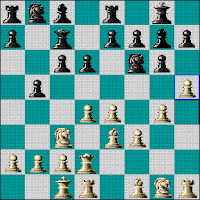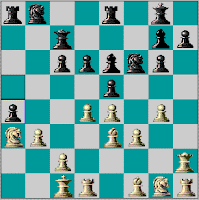Tuesday night saw East Cheshire A team playing fellow strugglers Chorlton. If there was a prize for worst playing venue in the Stockport league then Chorlton would almost certainly win it. It seems like there are no brooms or paint brushes in Manchester these days. And the landlords were obviously saving energy costs by only turning the heating on 10 minutes before the match started!
Despite the less than salubrious surrounding we managed to win the match 4-2, no thanks to my miserable defeat on board 4.
On board 5 Tudor gave Mr Sainsbury another lesson in the inherent problems with the Pirc defense! Actually the opening was not the cause of the defeat and in a totally unclear position it could have been anyone’s game.
So here is the game with notes by Tudor unless otherwise stated.
Rickards v Sainsbury
Feb 11th 2009
E Cheshire v Chorlton
I have a feeling this game will be trashed by Fritz. Who cares what a slice of silicon can do?
1 e4 d6;
2 d4 Nf6;
3 Nc3 g6;
4 f3 (classical system I found out afterwards. Crude and tactical).
4 ..Bg7;
5 Be3 (not popular. More common is Be2. Go on Fritz. Hit me). (actually this is the main line! – Phil)
5 …O-O;
6 Qd2 Re8; (let’s preserve the bishop, if 7 Bh6);
7 O-O-O c6; ( pawn push game coming up. Thought briefly of 8 Kb1 to avoid nasties on the a file and sacs plus Bh6 to win queen. Decided to press on);
8 g4 (opponent thought of 8.. Bxg4, 9..Nxg4 with those threats to my king 10 Bh6. I didn’t think much. Piece for 2ps, But I do have to give up nice bishop for knight)
8 ..Qc7 ; (Seemed a bit slow in hindsight. But it might force me to make that move Kb1);
9 h4 (sacs still about same as last move) 9 …b5 ; (time to think. Continue K side push, or move Kt. Decided K side push, stick Kt(c3) on b1 not on e2 so I could have play on the a2-g8 diagonal for my bishop. Almost certainly meant losing the a pawn and nasties down the h8-a1 diagonal. So
10 h5 critical position.
 10 …e5!? ; (didn’t expect it. Expected 10 …b5 when would have played 11 Nb1 and if 11 ..Qa5, h5xg6 with complex game but a nice open h file).
10 …e5!? ; (didn’t expect it. Expected 10 …b5 when would have played 11 Nb1 and if 11 ..Qa5, h5xg6 with complex game but a nice open h file).
11 hxg6 …fxg6;
12 Qh2 (not totally crude as it has ties down the black Kt to defence 12 …b4
13 Nb1 13 ..Be6;
14 b3 (?! Or ? Had rough plan of c4, and looked at ..exd4, Red4) …14 …a5 (back to pushing)
15 a4 ? (why didn’t I stick to my earlier idea of c4?) 15 … pxp a3 (e.p.) ;
16 Nx a3 …16 ..a4 ;
 Now I thought the tactics were turning against me.
Now I thought the tactics were turning against me.
THIS IS THE MOST COMPLEX SITUATION REACHED SO FAR. MAYBE I COULD FIND A HOLDING MOVE. OK FRITZ. DO YOUR WORSE. position is incalculable. I now was seriously worried and needed to find a way of dealing with a4 x b3. Worse, I was running out of Lucazade. I thought the best option is to continue to create threats maybe as the attacking moves are a kind of defence which black may have to attend to.
17 Nc4 axb;
18 d x e b x c?; (had worried more about 18 …R a1+ 1; 18 b2 + is also good ) (chesslab.com gives the variation 18. … Ra1+ 19. Kd2 Ra2 20. Bd3 dxe5 21. Kc3 bxc2 22. Bxc2 Nbd7 with a 2 pawn advantage to Black – Phil.)
19 R x d6 (was considering this anyway, and black’s 18th makes it more attractive)
…19 R a1+;
20 K x c2 Ra2 +;
21 Nb2 (One point of 17 Nc4, I was worried about losing Q along the 2nd rank)
 Now black launches into attractive series of sacs which probably entranced him. Simpler moves must give him more, and probably there’s a direct win. Now it simplifies to a slight plus for white
Now black launches into attractive series of sacs which probably entranced him. Simpler moves must give him more, and probably there’s a direct win. Now it simplifies to a slight plus for white
21 … R x Kt (!?);
22 K x Kt and now …Q x R (now I see what he’s up to, entire sequence is maybe !?)
23 e x Q d6 23 Kt x g4 (disc +);
24 K- c2 Kt x Q h2;
25 R x Kt h2 B-e5;
26 R – d2 (lucky me)

After a lot of careful trap-avoiding I force win on ca move 56 through strong connected passed pawns in centre. In this ending I needed to avoid swapping pieces as much as possible.
5. Bg5 Be7
Ooops! Black’s queen is in danger of being trapped and most of his pieces are mere spectators.
What a crush! A great reason to play 1. d4, except that most of the time you will find yourself in a Nimzo, or a King’s Indian, or a Slav…